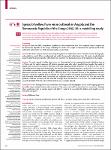Spread of yellow fever virus outbreak in Angola and the Democratic Republic of the Congo 2015–16: a modelling study
Kraemer, Moritz U. G.
Faria, Nuno R.
Jr., Robert C. Reiner
Golding, Nick
Nikolay, Birgit
Stasse, Stephanie
Johansson, Michael A.
Salje, Henrik
Faye, Ousmane
Wint, G. R. William
Niedrig, Matthias
Shearer, Freya M.
Hill, Sarah C.
Thompson, Robin N.
Bisanzio, Donal
Taveira, Nuno
Nax, Heinrich H.
Pradelski, Bary S. R.
Nsoesie, Elaine O.
Murphy, Nicholas R
Bogoch, Isaac I.
Khan, Kamran
Brownstein, John S.
Tatem, Andrew J.
Oliveira, Tulio de
Background: Since late 2015, an epidemic of yellow fever has caused more than 7334 suspected cases in Angola and the Democratic Republic of the Congo, including 393 deaths. We sought to understand the spatial spread of this outbreak to optimise the use of the limited available vaccine stock. Methods: We jointly analysed datasets describing the epidemic of yellow fever, vector suitability, human demography, and mobility in central Africa to understand and predict the spread of yellow fever virus. We used a standard logistic model to infer the district-specific yellow fever virus infection risk during the course of the epidemic in the region. Findings: The early spread of yellow fever virus was characterised by fast exponential growth (doubling time of 5–7 days) and fast spatial expansion (49 districts reported cases after only 3 months) from Luanda, the capital of Angola. Early invasion was positively correlated with high population density (Pearson's r 0·52, 95% CI 0·34–0·66). The further away locations were from Luanda, the later the date of invasion (Pearson's r 0·60, 95% CI 0·52–0·66). In a Cox model, we noted that districts with higher population densities also had higher risks of sustained transmission (the hazard ratio for cases ceasing was 0·74, 95% CI 0·13–0·92 per log-unit increase in the population size of a district). A model that captured human mobility and vector suitability successfully discriminated districts with high risk of invasion from others with a lower risk (area under the curve 0·94, 95% CI 0·92–0·97). If at the start of the epidemic, sufficient vaccines had been available to target 50 out of 313 districts in the area, our model would have correctly identified 27 (84%) of the 32 districts that were eventually affected. Interpretation: Our findings show the contributions of ecological and demographic factors to the ongoing spread of the yellow fever outbreak and provide estimates of the areas that could be prioritised for vaccination, although other constraints such as vaccine supply and delivery need to be accounted for before such insights can be translated into policy.
No license information
Related Items
Show related Items with similar Title, Author, Creator or Subject.
-
2012-12-26ZeitschriftenartikelBiological and Phylogenetic Characteristics of Yellow Fever Virus Lineages from West Africa Stock, Nina K.; Laraway, Hewád; Faye, Ousmane; Diallo, Mawlouth; Niedrig, Matthias; Sall, Amadou A.The yellow fever virus (YFV), the first proven human-pathogenic virus, although isolated in 1927, is still a major public health problem, especially in West Africa where it causes outbreaks every year. Nevertheless, little ...
-
2010-11-24ZeitschriftenartikelDetection of yellow fever 17D genome in urine Domingo, Cristina; Yactayo, Sergio; Agbenu, Edinam; Demanou, Maurice; Schulz, Axel R.; Daskalow, Katjana; Niedrig, Matthias
-
2012-05-03ZeitschriftenartikelFirst International External Quality Assessment Study on Molecular and Serological Methods for Yellow Fever Diagnosis Domingo, Cristina; Escadafal, Camille; Rumer, Leonid; Méndez, Jairo A.; García, Paquita; Sall, Amadou A.; Teichmann, Anette; Mantke, Oliver Donoso; Niedrig, MatthiasObjective: We describe an external quality assurance (EQA) study designed to assess the efficiency and accurateness of molecular and serological methods used by expert laboratories performing YF diagnosis. Study Design: ...

